Tunable Broadband Terahertz Metamaterial Absorber Based on Vanadium Dioxide and Graphene
Abstract
:1. Introduction
2. Structure Design and Method
3. Results and Discussion
4. Conclusions
Author Contributions
Funding
Data Availability Statement
Acknowledgments
Conflicts of Interest
References
- Luo, H.; Cheng, Y. Thermally tunable terahertz metasurface absorber based on all dielectric indium antimonide resonator structure. Opt. Mater. 2020, 102, 109801. [Google Scholar] [CrossRef]
- Han, X.; Xiao, D.M.; Zhang, H. Wave-thermal effect of a temperature-tunable terahertz absorber. Opt. Express 2021, 29, 38557. [Google Scholar]
- Shah, A.R.; Naveed, M.A.; Ijaz, S.; Rahim, A.A.; Zubair, M.; Massoud, Y.; Mehmood, M.Q. A functionality switchable meta-device: From perfect reflection to perfect absorption. Phys. Scr. 2023, 98, 095514. [Google Scholar] [CrossRef]
- Zakir, S.; Bilal, R.M.H.; Naveed, M.A.; Baqir, A.; Khan, M.U.A.; Ali, M.M.; Saeed, M.A.; Mehmood, M.Q.; Massoud, Y. Polarization-Insensitive, Broadband, and Tunable Terahertz Absorber Using Slotted-Square Graphene Meta-Rings. IEEE Photonics J. 2023, 15, 4600108. [Google Scholar] [CrossRef]
- Landy, N.I.; Sajuyigbe, S.; Mock, J.J.; Smith, D.R.; Padilla, W.J. Perfect Metamaterial Absorber. Phys. Rev. Lett. 2008, 100, 279–282. [Google Scholar] [CrossRef] [PubMed]
- Long, Y.; Shen, L.; Xu, H.; Deng, H.; Li, Y. Achieving ultranarrow graphene perfect absorbers by exciting guided-mode resonance of one-dimensional photonic crystals. Sci. Rep. 2016, 6, 32312. [Google Scholar] [CrossRef]
- Wen, Q.Y.; Zhang, H.W.; Xie, Y.S.; Yang, Q.H.; Liu, Y.L. Dual band terahertz metamaterial absorber: Design, fabrication, and characterization. Appl. Phys. Lett. 2009, 95, 207402. [Google Scholar] [CrossRef]
- Li, M.; Liang, C.; Zhang, Y.; Yi, Z.; Chen, X.; Zhou, Z.; Yang, H.; Tang, Y.; Yi, Y. Terahertz wideband perfect absorber based on open loop with cross nested structure—Sciencedirect. Results Phys. 2019, 15, 102600–102603. [Google Scholar] [CrossRef]
- Hu, D.; Wang, H.Y.; Zhu, Q.F. Design of six-band terahertz perfect absorber using a simple U-shaped closed-ring resonator. IEEE Photonics J. 2016, 8, 1–8. [Google Scholar] [CrossRef]
- Bao, Z.Y.; Wang, J.C.; Hu, Z.D. Coordinated multi-band angle insensitive selection absorber based on graphene metamaterials. Opt. Express 2019, 27, 31435–31445. [Google Scholar] [CrossRef] [PubMed]
- Sun, P.; Zhou, C.; Jia, W.; Wang, J.; Xiang, C.; Xie, Y.; Zhao, D. Narrowband absorber based on magnetic dipole resonances in two-dimensional metal–dielectric grating for sensing. Opt. Commun. 2020, 459, 12946. [Google Scholar] [CrossRef]
- Huang, L.; Chowdhury, D.R. Experimental demonstration of terahertz metamaterial absorbers with a broad and flat high absorption band. Opt. Lett. 2012, 37, 154. [Google Scholar] [CrossRef]
- Cai, Y.J.; Xu, K.D. Tunable broadband terahertz absorber based on multilayer graphene-sandwiched plasmonic structure. Opt. Express 2018, 26, 31693–31705. [Google Scholar] [CrossRef] [PubMed]
- Li, H.; Yu, J. Bifunctional terahertz absorber with a tunable and switchable property between broadband and dual-band. Opt. Express 2020, 28, 25225–25237. [Google Scholar] [CrossRef]
- Kepi, P.; Ligmajer, F.; Hrtoň, M.; Ren, H.; Menezes, L.D.S.; Maier, S.A.; Šikola, T. Optically tunable mie-resonance VO2 nanoantennas for metasurfaces in the visible. ACS Photonics 2021, 8, 1048–1057. [Google Scholar] [CrossRef]
- Lei, L.; Lou, F.; Tao, K.; Huang, H.; Cheng, X.; Xu, P. Tunable and scalable broadband metamaterial absorber involving VO2-based phase transition. Photonics Res. 2019, 7, 734–741. [Google Scholar] [CrossRef]
- He, J.; Zhang, M.; Shu, S.; Yan, Y.; Wang, M. VO2 based dynamic tunable absorber and its application in switchable control and real-time color display in the visible region. Opt. Express 2020, 28, 37590–37599. [Google Scholar] [CrossRef]
- Chen, S.Q.; Cheng, H.; Yang, H.F. Polarization insensitive and omnidirectional broadband near perfect planar metamaterial absorber in the near infrared regime. Appl. Phys. Lett. 2011, 99, 253104. [Google Scholar] [CrossRef]
- Zhang, Y.B.; Liu, W.W.; Li, Z.C. Ultrathin polarization-insensitive wide-angle broadband near-perfect absorber in the visible regime based on few-layer MoS2 films. Appl. Phys. Lett. 2017, 111, 111109. [Google Scholar] [CrossRef]
- Zhao, Y.T.; Wu, B.; Huang, B.J. Switchable broadband terahertz absorber/reflector enabled by hybrid graphene-gold metasurface. Opt. Express 2017, 25, 7161–7169. [Google Scholar] [CrossRef] [PubMed]
- Xiong, H.; Wu, Y.B.; Dong, J.M.; Tang, M.-C.; Jiang, Y.-N.; Zeng, X.-P. Ultra-thin and broadband tunable metamaterial graphene absorber. Optic Express 2018, 26, 1681–1688. [Google Scholar] [CrossRef]
- Wang, Y.; Song, M.; Pu, M.; Gu, Y.; Hu, C.; Zhao, Z.; Wang, C.; Yu, H.; Luo, X. Luo. Staked graphene for tunable terahertz absorber with customized bandwidth. Plasmonics 2016, 11, 1201–1206. [Google Scholar] [CrossRef]
- Smith, D.R.; Vier, D.C.; Koschny, T. Electromagnetic parameter retrieval from inhomogeneous metamaterials. Phys. Rev. E 2005, 71, 036617. [Google Scholar] [CrossRef]
- Mou, N.L.; Sun, S.L.; Dong, H.X.; Dong, S.H.; He, Q.; Zhou, L.; Zhang, L. Hybridization-induced broadband terahertz wave absorption with graphene metasurfaces. Opt. Express 2018, 26, 11728–11736. [Google Scholar] [CrossRef]
- Sun, P.; You, C.; Mahigir, A.; Liu, T.; Xia, F.; Kong, W.; Veronis, G.; Dowling, J.P.; Dong, L.; Yun, M. Graphene-based dual-band independently tunable infrared absorber. Nanoscale 2018, 10, 15564–15570. [Google Scholar] [CrossRef]
- Hanson, G.W. Dyadic Green’s functions and guided surface waves for a surface conductivity model of graphene. J. Appl. Phys. 2008, 103, 064302. [Google Scholar] [CrossRef]
- Hu, N.; Wu, F.L.; Bian, L.A. Dual broadband absorber based on graphene metamaterial in the terahertz range. Opt. Mater. Express 2018, 8, 3899. [Google Scholar] [CrossRef]
- Liu, M.; Yin, X.B. A graphene-based broadband optical modulator. Nature 2011, 474, 64–67. [Google Scholar] [CrossRef]
- Wang, S.X.; Kang, L.; Werner, D.H. Hybrid resonators and highly tunable terahertz metamaterials enabled by vanadium dioxide (VO2). Sci. Rep. 2017, 7, 4326. [Google Scholar] [CrossRef]
- Tian, X.M.; Li, Z.Y. An optically-triggered switchable mid-infrared perfect absorber based on phase-change material of vanadium dioxide. Plasmonics 2018, 13, 1393–1402. [Google Scholar] [CrossRef]
- Ruzmetov, D.; Gopalakrishnan, G.; Deng, J. Electrical triggering of metal-insulator transition in nanoscale vanadium oxide junctions. J. Appl. Phys. 2009, 106, 083702. [Google Scholar] [CrossRef]
- Wen, Q.Y.; Zhang, H.W.; Yang, Q.H. Terahertz metamaterials with VO2 cut-wires for thermal tunability. Appl. Phys. Lett. 2010, 97, 021111. [Google Scholar] [CrossRef]
- Lin, Z.; Ye, X.; Han, J.; Chen, Q.; Fan, P.; Zhang, H.; Xie, D.; Zhu, H.; Zhong, M. Precise control of the number of layers of graphene by picosecond laser thinning. Sci. Rep. 2015, 5, 11662. [Google Scholar] [CrossRef] [PubMed]
- Yue, Y.; Chen, Y.; Wang, S.; Zhang, N.; Li, A.; Yang, H. A simple method for the preparation of patterned graphene electrodes and its application in organic lightemitting diodes array. Mater. Lett. 2019, 251, 152–155. [Google Scholar] [CrossRef]
- Meng, K.; Park, S.J.; Li, L.H.; Bacon, D.R.; Chen, L.; Chae, K.; Park, J.Y.; Burnett, A.D.; Linfield, E.H.; Davies, A.G.; et al. Tunable broadband terahertz polarizer using graphene-metal hybrid metasurface. Opt. Express 2019, 27, 33769–33779. [Google Scholar] [CrossRef]
- Watts, C.M.; Liu, X.; Padilla, W.J. Metamaterial electromagnetic wave absorbers. Adv. Mater. 2012, 24, OP98–OP120. [Google Scholar] [CrossRef]
- Pan, W.; Yu, X.; JZhang Zeng, W. A broadband terahertz metamaterial absorber based on two circular split rings. IEEE J. Quantum Electron. 2018, 53, 8500206. [Google Scholar] [CrossRef]
- Zhu, J.; Li, C.; Ou, J.-Y.; Liu, Q.H. Perfect light absorption in graphene by two unpatterned dielectric layers and potential applications. Carbon 2019, 142, 430–437. [Google Scholar] [CrossRef]
- Wang, G.; Wu, T.; Jiang, J.; Jia, Y.; Gao, Y.; Gao, Y. Switchable terahertz absorber from single broadband to triple-narrowband. Diam. Relat. Mater. 2022, 130, 109460. [Google Scholar] [CrossRef]
- Liu, Y.; Huang, R.; Ouyang, Z. Terahertz absorber with dynamically switchable dual-broadband based on hybrid metamaterial with vanadium dioxide and graphene. Opt. Express 2021, 29, 13. [Google Scholar] [CrossRef]
- Badri, S.H.; Gilarlue, M.M.; Saeidnahaei, S.; Kim, J.S. Narrowband-to-broadband switchable and polarization-insensitive terahertz metasurface absorber enabled by phase-change material. J. Opt. 2022, 24, 025101. [Google Scholar] [CrossRef]
- Zhou, R.; Jiang, T.; Peng, Z.; Li, Z.; Zhang, M.; Wang, S.; Li, L.; Liang, H.; Ruan, S.; Su, H. Tunable broadband terahertz absorber based on graphene metamaterials and VO2. Opt. Mater. 2021, 114, 110915. [Google Scholar] [CrossRef]
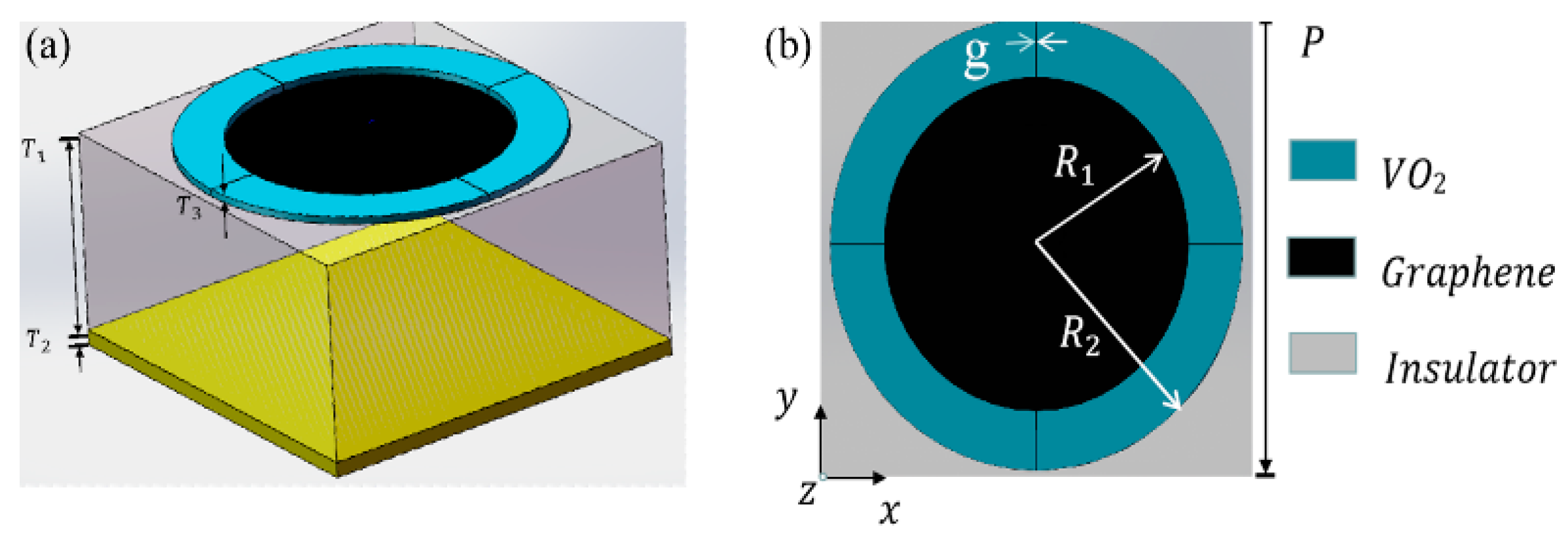
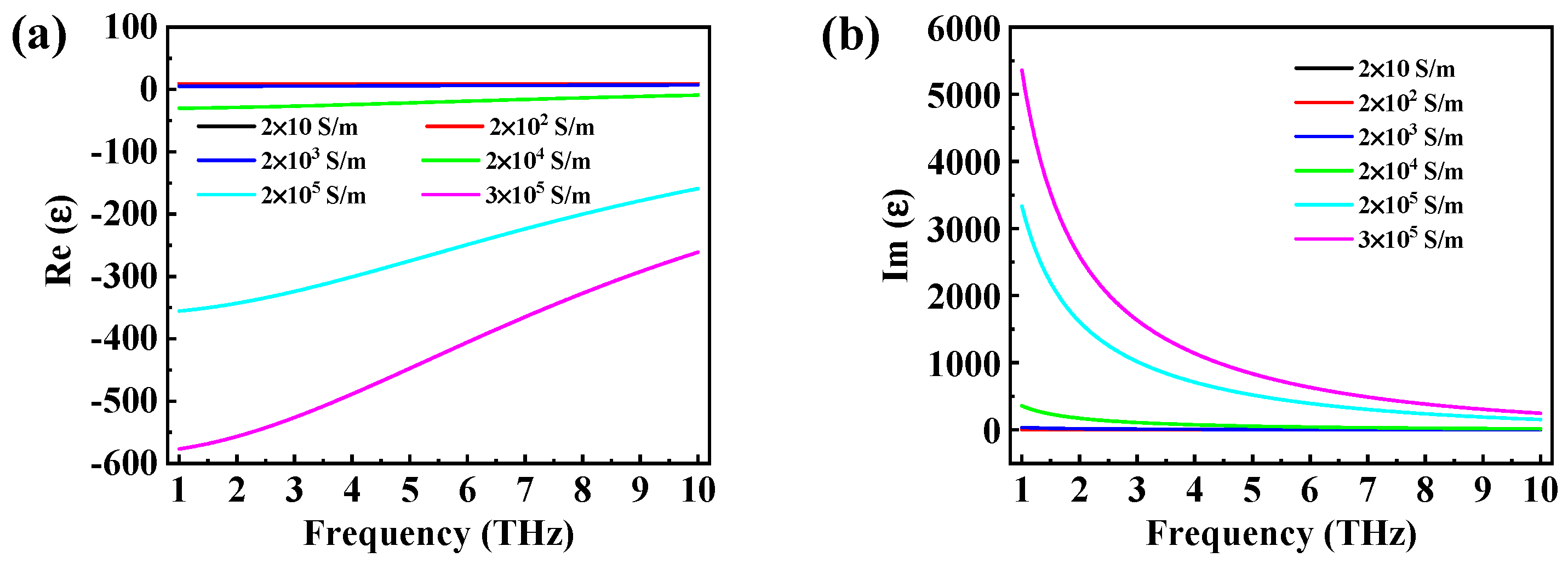
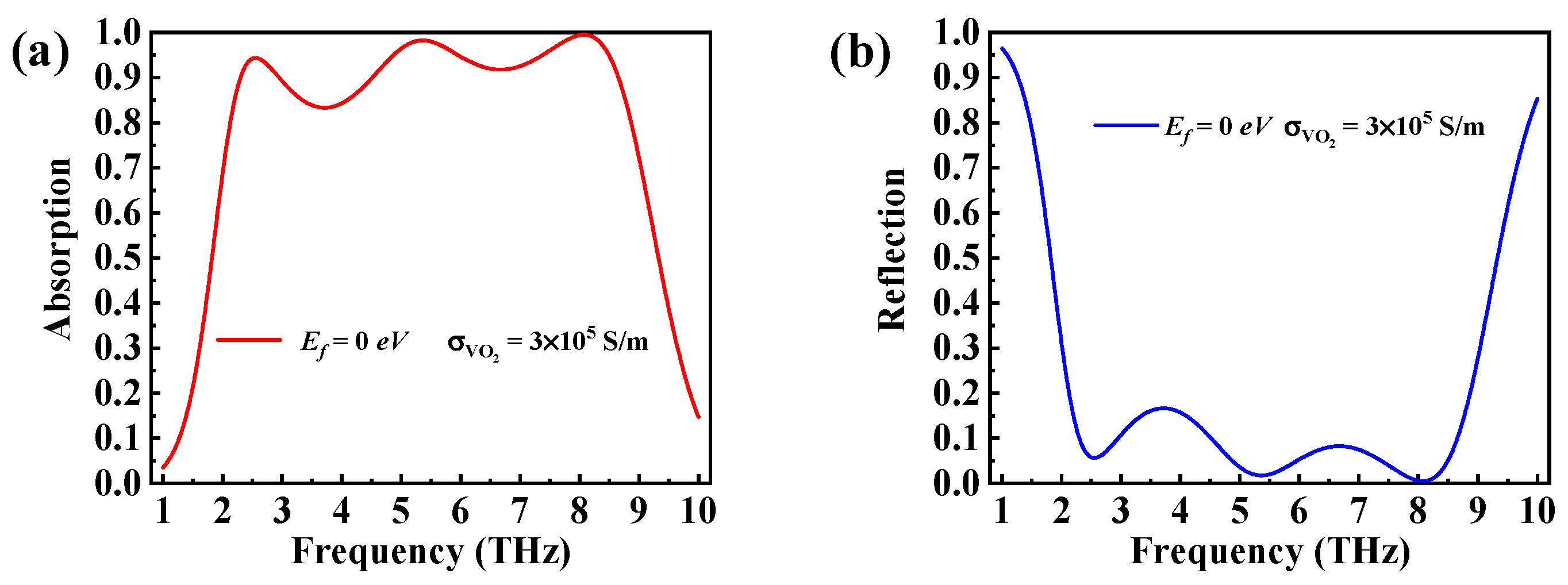
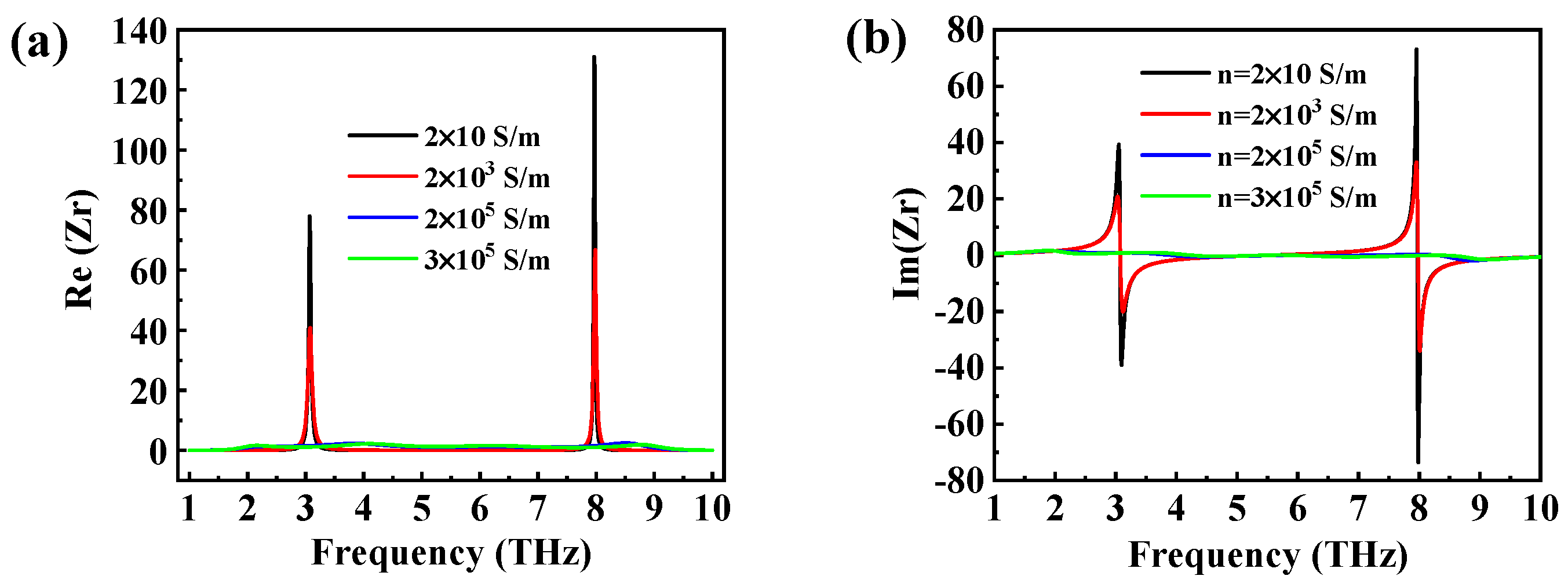
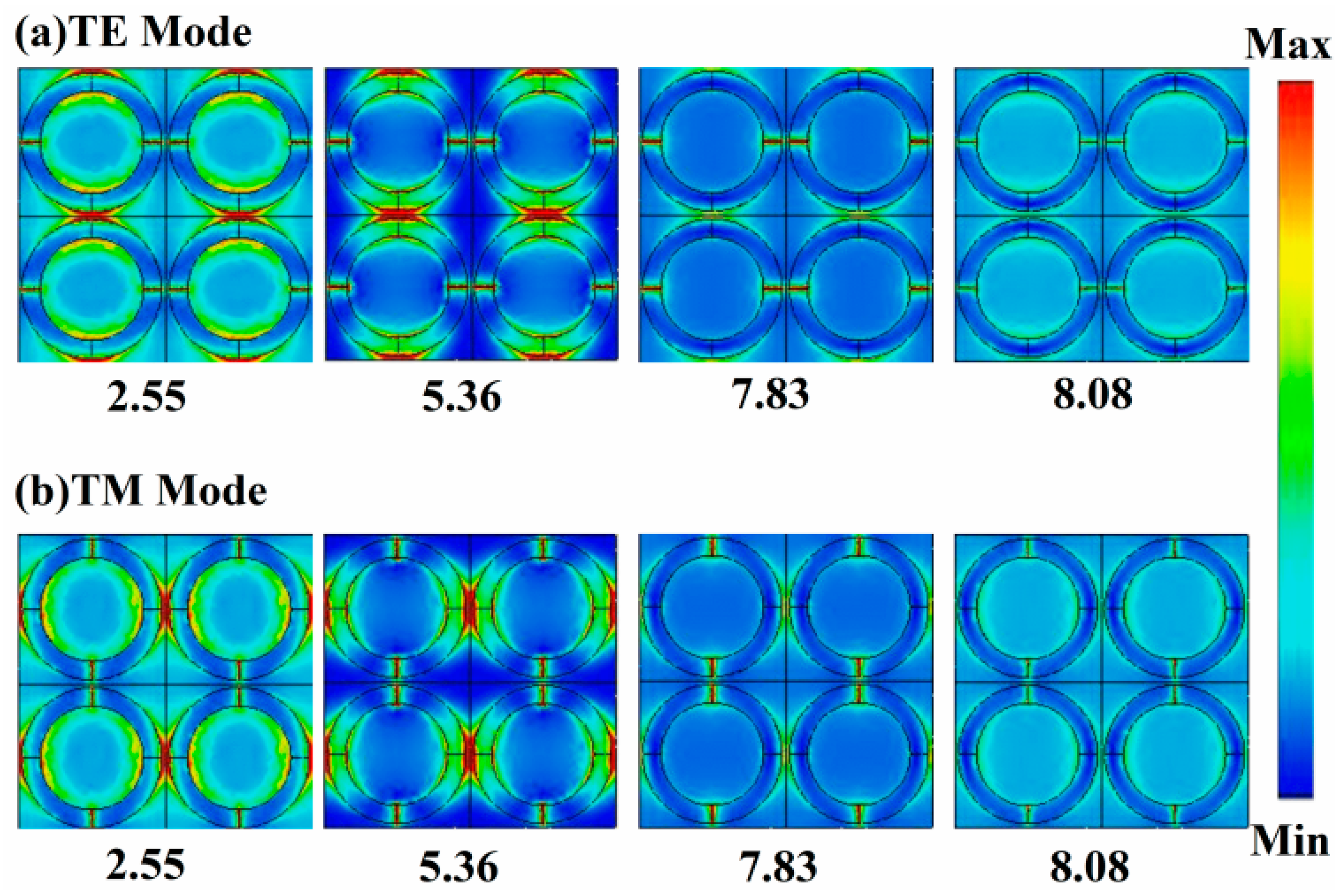
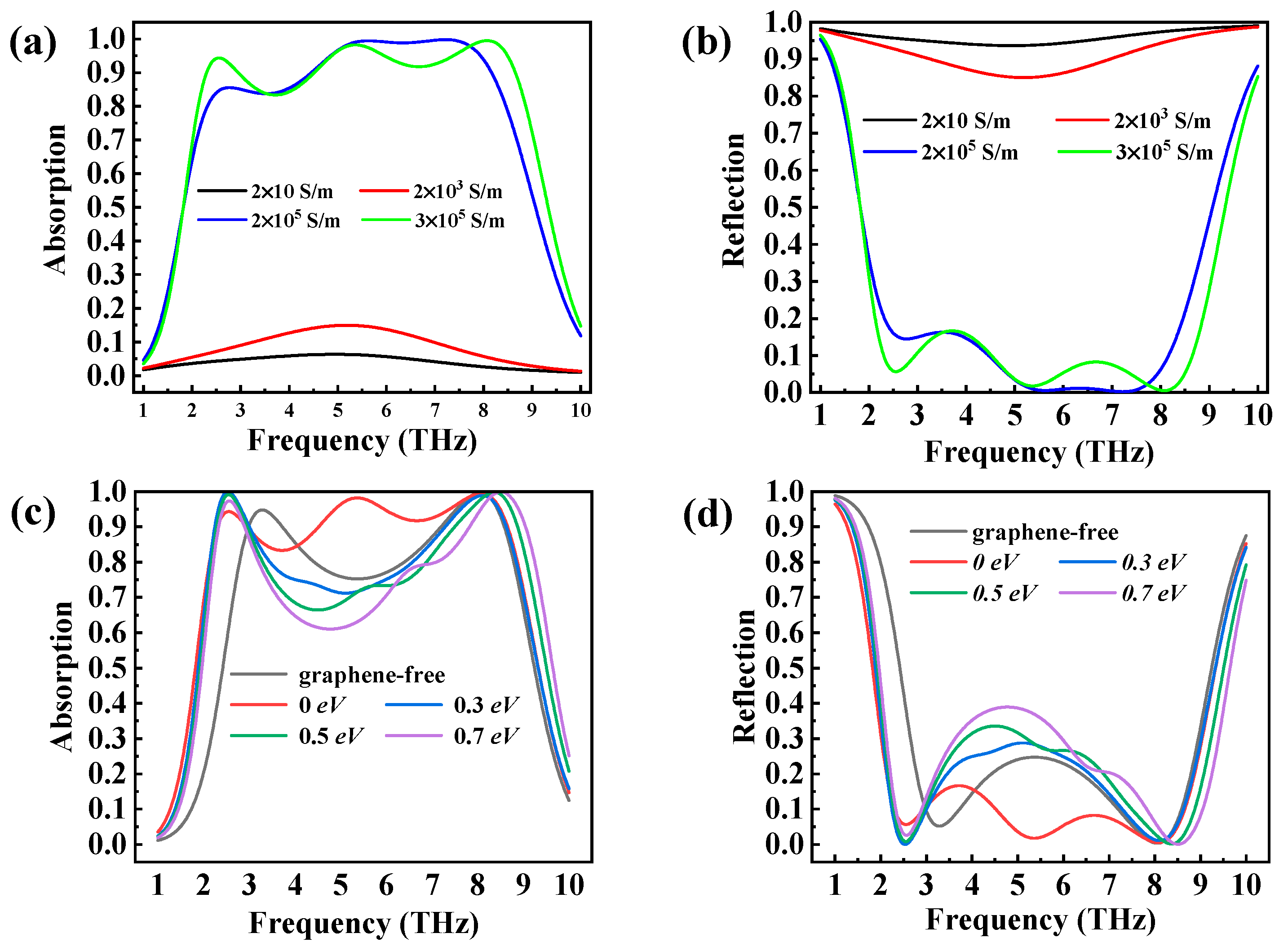
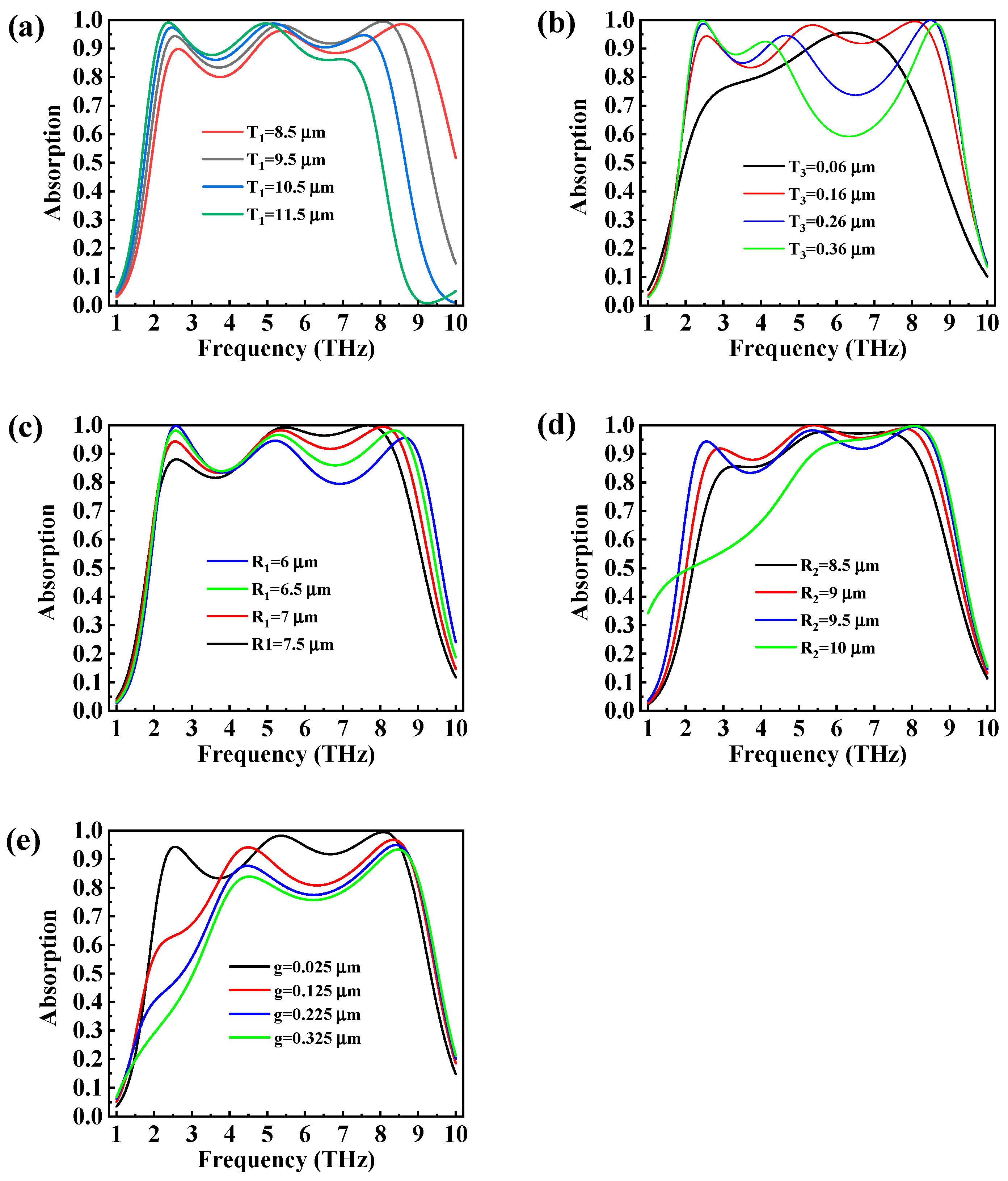
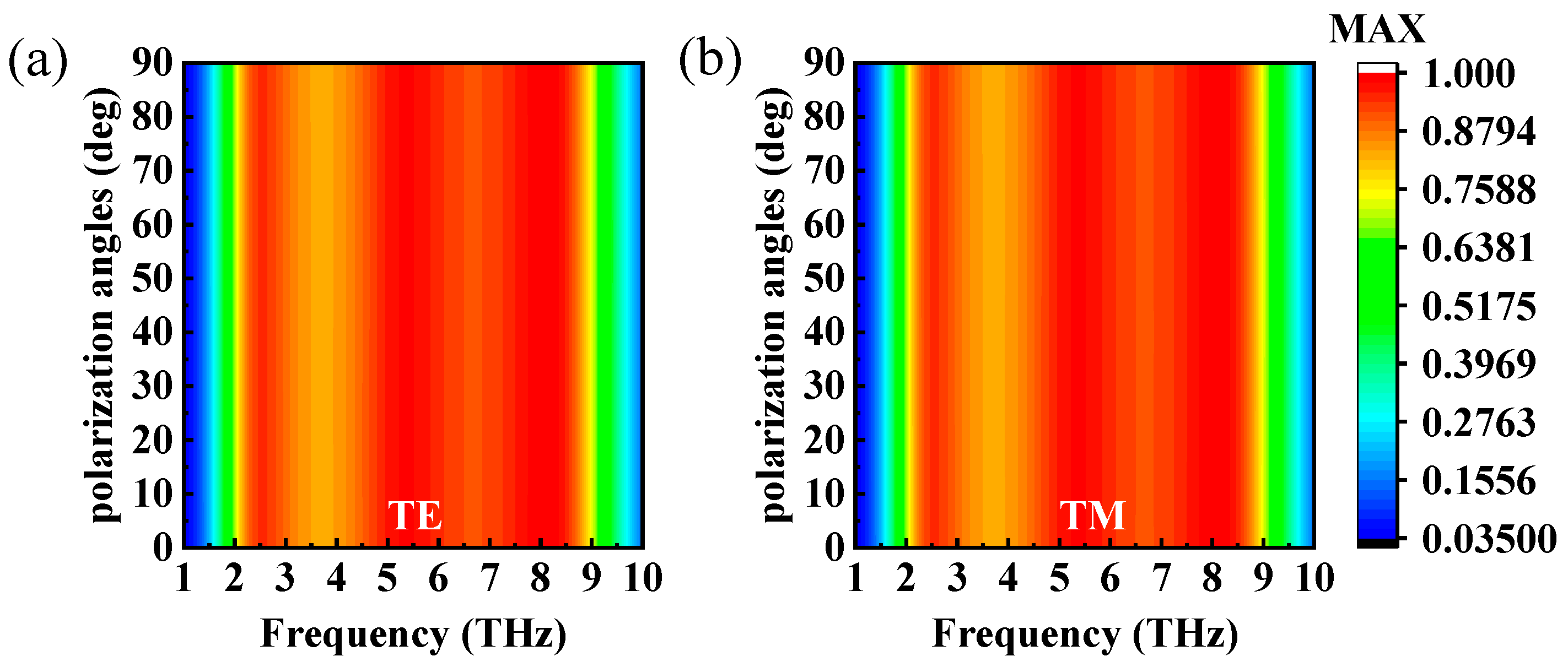
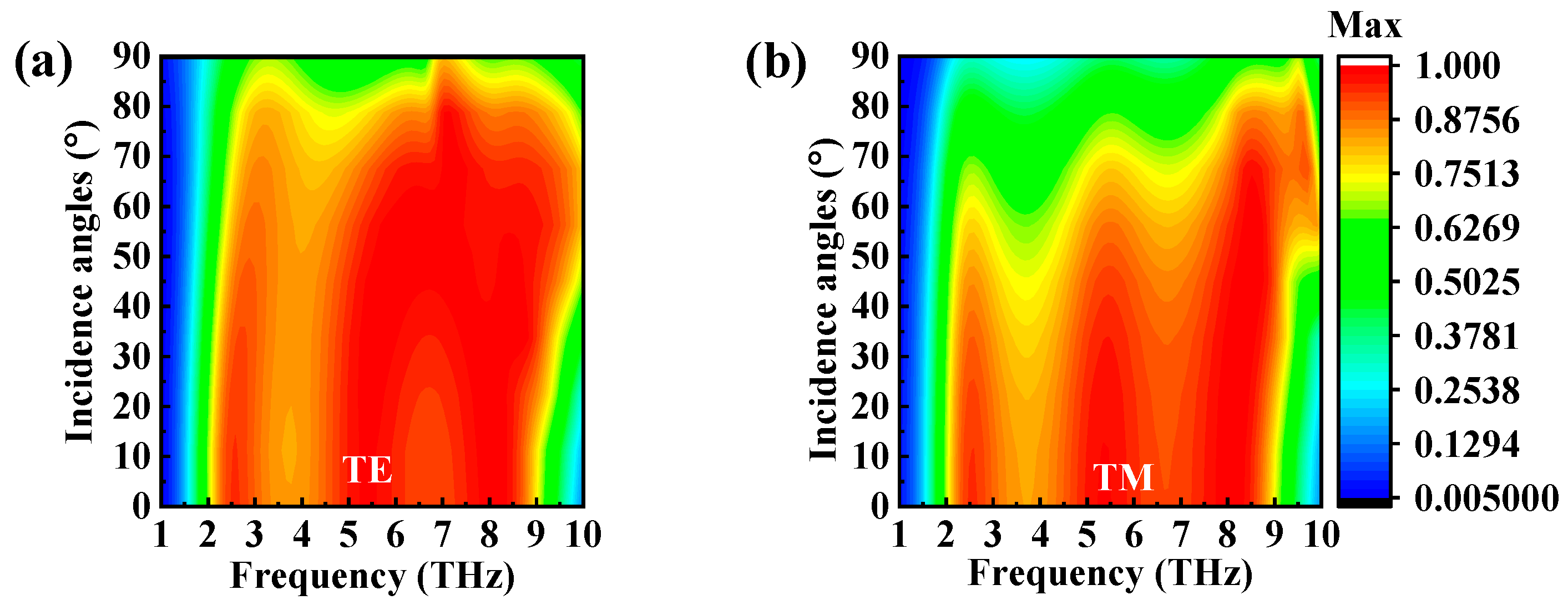
| References | Constitutive Materials | Number of Layers | Absorption Bandwidth (THz) | Angular Stability | Polarization Insensitive |
|---|---|---|---|---|---|
| [39] | Graphene and VO2 | 7 | 1.6 (0.8–2.4) | 55 | Yes |
| [40] | Graphene and VO2 | 6 | 1.3 (1.05–2.35) | 50 | Yes |
| [41] | VO2 | 3 | 3.3 (2.34–5.64) | 55 | Yes |
| [42] | Graphene and VO2 | 3 | 1.03 (1–2.03) | 50 | No |
| This work | Graphene and VO2 | 4 | 6.35 (2.30–8.65) | 50 | Yes |
Disclaimer/Publisher’s Note: The statements, opinions and data contained in all publications are solely those of the individual author(s) and contributor(s) and not of MDPI and/or the editor(s). MDPI and/or the editor(s) disclaim responsibility for any injury to people or property resulting from any ideas, methods, instructions or products referred to in the content. |
© 2023 by the authors. Licensee MDPI, Basel, Switzerland. This article is an open access article distributed under the terms and conditions of the Creative Commons Attribution (CC BY) license (https://creativecommons.org/licenses/by/4.0/).
Share and Cite
Zheng, L.; Feng, R.; Shi, H.; Li, X. Tunable Broadband Terahertz Metamaterial Absorber Based on Vanadium Dioxide and Graphene. Micromachines 2023, 14, 1715. https://doi.org/10.3390/mi14091715
Zheng L, Feng R, Shi H, Li X. Tunable Broadband Terahertz Metamaterial Absorber Based on Vanadium Dioxide and Graphene. Micromachines. 2023; 14(9):1715. https://doi.org/10.3390/mi14091715
Chicago/Turabian StyleZheng, Laifang, Rui Feng, Huanting Shi, and Xuanjing Li. 2023. "Tunable Broadband Terahertz Metamaterial Absorber Based on Vanadium Dioxide and Graphene" Micromachines 14, no. 9: 1715. https://doi.org/10.3390/mi14091715
APA StyleZheng, L., Feng, R., Shi, H., & Li, X. (2023). Tunable Broadband Terahertz Metamaterial Absorber Based on Vanadium Dioxide and Graphene. Micromachines, 14(9), 1715. https://doi.org/10.3390/mi14091715




